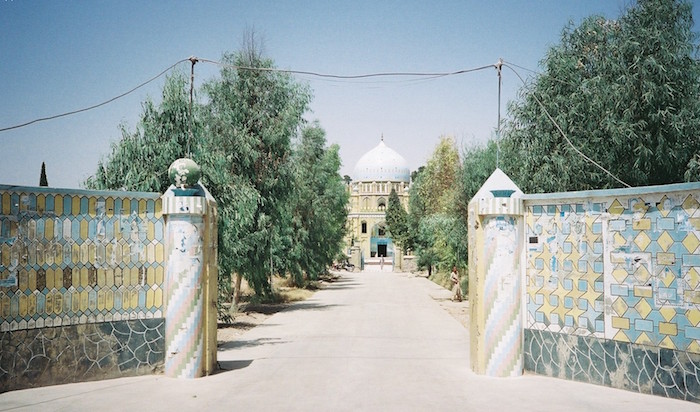Once a month here on the Molten Sulfur Blog, I run content taken from our book Archive: Historical People, Places, and Events for RPGs. This post, about the Shrine of the Cloak in Afghanistan, is one of eighty entries in Archive, each more gameable than the last!

The Shrine of the Cloak
Style for the Powerful
For 250 years, Afghanistan’s most sacred artifact, a cloak said to have been worn by the prophet Muhammed (p.b.u.h.), was protected by generations of a family in Kandahar. The honor of guardianship comes at a high price. At least five previous guardians were assassinated, murdered in their offices, in markets, and in airports. The Taliban, Afghanistan’s dominant jihadi group, was willing to kill just about anyone to acquire the cloak. When Masood Akhundzada, the cloak’s current guardian, accepted the keys to its shrine in 2008, he also got a gun.
The cloak is kept out of sight in a beautiful shrine. Worshippers walk past walls of patterned stone to an archway blocked by a padlocked door. They press their lips to it, offering up prayers. Symbols are sometimes as important as territory in the war between the Taliban and the Afghan government. Korans and mosques are common, but the cloak is more specific and sacred. Many Afghans fear that if the violence in Kandahar continues, the cloak and other important symbols could be lost, leaving guardians like Akhundzada in a dangerous position.
In 1996, the Taliban took Kandahar. The Akhundzada family allowed the one-eyed Taliban leader, Mullah Omar, into the heart of the shrine, but they didn’t expect him to actually take up the cloak. Omar brought the cloak to the roof of a mosque in central Kandahar and slipped it on himself in front of a roaring crowd. The act cemented his power as the commander of the faithful among the Taliban, and later Osama bin Laden came to the city to commend him.
The sudden public unveiling of the cloak was a global shock. It had always been a symbol of power, only revealed to quell hysteria in the aftermath of natural disasters. But suddenly the cloak made its way to foreign newspapers, intelligence reports, and Taliban propaganda pamphlets. Akhundzada’s relatives considered themselves neutral protectors of the sacred, but they were now protecting the cloak on behalf of the Taliban, and thrust into Afghanistan’s bloody political arena. Their survival hinged on their neutrality. If they were seen as politically involved, their lives would be in danger. With the ceaseless regime changes in Afghanistan, they might hand the cloak to a king one day and his usurper the next.
When the Taliban took control, the family was concerned, especially after Akhundzada’s brother was killed in an airport. In 2001, forces nominally loyal to the new American-backed Afghan government liberated Kandahar. There was a short time when it was thought the Taliban escaped with the cloak, but luckily, it was said to have been found in the shrine. The Taliban quickly returned to Kandahar with new targets, including the guardians of the cloak. Akhundzada’s nephew was killed first, shot in the face in his office in 2005. Assassins killed another brother of Akhundzada’s and his cousin in 2008. Even Akhundzada was nearly killed in a suicide bombing shortly after becoming the new guardian of the shrine.
Akhundzada is willing to die for the cloak, though he has never seen it himself. It has remained locked in the shrine since he assumed his position, and it will remain unseen so long as the president doesn’t ask for it to be unveiled. Security around the shrine has been boosted, and Akhundzada knows he and his family are being targeted by the Taliban for protecting the sacred. But they try to cling to their neutrality. The symbol of the cloak is too powerful not to.
The Shrine of the Cloak in Play
The Shrine of the Cloak could be a flashpoint for conflict in your campaign. Akhundzada might hire the PCs to investigate a string of attempts on his life. If your campaign features a civil war, acquiring the cloak – or an artifact like it – could bring the PCs’ side legitimacy. But if after trying to convince him, Akhundzada isn’t willing to give it up, is the party willing to steal it? What if in the process of stealing the cloak, whether for politics or for profit, the PCs discover it isn’t actually in the shrine anymore? Maybe someone else stole it first. Maybe a branch of the Akhudzada family hid it elsewhere for safekeeping. Or maybe the last side to claim the cloak absconded with it, only to lose it in some meaningless ambush, leaving the cloak in the possession of bandits or guerrillas who don’t even know what they have.






